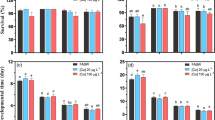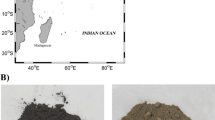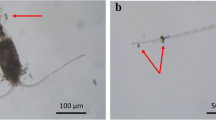Abstract
Tigriopus japonicus Mori has been recognized as a good model for toxicological testing of marine pollutants. Recently, a large number of genes have been identified from this copepod, and their mRNA expression has been studied independently against exposure to marine pollutants; however, biochemical-response information is relatively scarce. The response of T. japonicus to nickel (Ni) additions was examined under laboratory-controlled conditions in 12 days exposure. Superoxide dismutase (SOD), glutathione peroxidase (GPx), glutathione-S-transferase (GST), acetylcholinesterase (AchE), reduced glutathione (GSH), the ratio of reduced to oxidized glutathione (GSH/GSSG) and metallothionein (MT) were analyzed for Ni treatments (0, 0.125, 0.25, 0.75 and 3.0 mg/L) after 1, 4, 7 and 12 days. The thiobarbituric reactive species assay was used to evaluate lipid peroxidation (LPO) level in copepods after exposure. The results showed that Ni remarkably affected the biochemical parameters (SOD, GPx, GST, GSH, and GSH/GSSG) after certain exposure durations. However, the copepod’s LPO level was significantly decreased under metal treatments after exposure, hinting that the factors involved in LPO might not significantly depend on the operations and functions in the antioxidant system. Ni exhibited the neurotoxicity to copepods, because its use obviously elevated AchE activity. During exposure, Ni initially displayed an inhibition effect but induced MT synthesis in T. japonicus by day 12, probably being responsible for metal detoxification. Thus, Ni had intervened in the detoxification process and antioxidant system of this copepod, and it could be used as a suitable bioindicator of Ni exposure via measuring SOD, GPx, GST, and MT as biomarkers.





Similar content being viewed by others
References
Amiard JC, Amiard-Triquet C, Barka S, Pellerin J, Rainbow PS (2006) Metallothioneins in aquatic invertebrates: their role in metal detoxification and their use as biomarkers. Aquat Toxicol 76:160–202
Amiard-Triquet C, Altmann S, Amiard JC, Ballan-Dufrancais C, Baumard P, Budzinski H, Crouzet C, Garrigues P, His E, Jeantet AY, Menasria R, Mora P, Mouneyrac C, Narbonne JF, Pavillon JF (1998) Fate and effects of micropollutants in the Gironde estuary, France: a multidisciplinary approach. Hydrobiologia 373(374):259–279
Ara K, Nojima K, Hiromi J (2002) Acute toxicity of Bunker A and C refined oils to the marine harpacticoid copepod Tigriopus japonicus Mori. Bull Environ Contam Toxicol 69:104–110
Barata C, Lekumberri I, Vila-Escalé M, Prat N, Porte C (2005a) Trace metal concentration, antioxidant enzyme activities and susceptibility to oxidative stress in the tricoptera larvae Hydropsyche exocellata from Llobregat river basin (NE Spain). Aquat toxicol 74:3–19
Barata C, Varo I, Navarro JC, Arun S, Porte C (2005b) Antioxidant enzyme activities and lipid peroxidation in the freshwater cladoceran Daphnia magna exposed to redox cycling compounds. Comp Biochem Physiol C 140:75–86
Barka S, Pavillon JF, Amiard JC (2001) Influence of different essential and non-essential metals on MTLP levels in the copepod Tigriopus brevicornis. Comp Biochem Physiol C 128:479–493
Bradford M (1976) A rapid and sensitive assay of protein utilizing the principle of dye binding. Analyt Biochem 772:248–264
Brown DA, Parsons TR (1978) Relationship between cytoplasmic distribution of mercury and toxic effects to zooplankton and chum salmon (Oncorhynchus keta) exposed to mercury in a controlled ecosystem. J Fish Res Board Can 35:800–884
Chakrabarti SK, Bai C (1999) Role of oxidative stress in nickel chloride-induced cell injury in rat renal cortical slices. Biochem Pharmacol 58:1501–1510
Chau YK, Kulikovsky-Cordeiro OTR (1995) Occurrence of nickel in the Canadian environment. Environ Rev 3:95–117
Chen CY, Wang YF, Lin YH, Yen SF (2003) Nickel-induced oxidative stress and effect of antioxidants in human lymphocytes. Arch Toxicol 77:123–130
Coogan TP, Latta DM, Snow ET, Costa M (1989) Toxicity and carcinogenicity of nickel compounds. Crit Rev Toxicol 19:341–384
Correia AD, Lima G, Costa MH, Livingstone DR (2002a) Studies on biomarkers of copper exposure and toxicity in the marine amphipod Gammarus locusta (Crustacea). I: induction of metallothionein and lipid peroxidation. Biomarkers 7:422–437
Correia AD, Livingstone DR, Costa MH (2002b) Effects of water-borne copper on metallothionein and lipid peroxidation in the marine amphipod Gammarus locusta. Mar Environ Res 54:357–360
Couillard Y, Campbell PGC, Tessier A, Pellerinmassicotte J, Auclair A (1995) Field transplantation of a fresh-water bivalve Pyganodon grandis, across a metal contamination gradient. Temporal changes in metallothionein and metal (Cd, Cu and Zn) concentrations in soft tissues. Can J Fish Aquat Sci 52:690–702
De Luca G, Gugliotta T, Parisi G, Romano P, Geraci A, Romano O, Scuteri A, Romano L (2007) Effects of nickel on human and fish blood cells. Biosci Rep 27:265–273
Durou C, Poirier L, Amiard JC, Budzinski H, Gnassia-Barelli M, Lemenach K, Peluhet L, Mouneyrac C, Roméo M, Amiard-Triquet C (2007) Biomonitoring in a clean and a multi-contaminated estuary based on biomarkers and chemical analyses in the endobenthic worm Nereis diversicolor. Environ Pollut 148:445–458
Eisler R (1998) Nickel hazards to fish, wildlife, and invertebrates: a synoptic review. US Geological Survey, Biological Resources Division, Biological Science Report, 1998–2001
Ellman G, Courtney K, Andres V, Featherstone RM (1961) A new and rapid colorimetric determination of acetylcholinesterase activity. Biochem Pharmacol 7:88–95
Elumalai M, Antunes C, Guilhermino L (2002) Single metals and their mixtures on selected enzymes of Carcinus maenas. Water Air Soil Pollut 141:273–280
Falfushynska HI, Stolyar OB (2009) Responses of biochemical markers in carp Cyprinus carpio from two field sites in Western Ukraine. Ecotoxicol Environ Saf 72:729–736
Forget J, Pavillon JF, Beliaeff B, Bocquené G (1999) Joint action of pollutant combinations (pesticides and metals) on survival (LC50 values) and acetylcholinesterase activity of Tigriopus brevicornis (Copepoda Harpacticoida). Environ Toxicol Chem 18:912–918
Forget J, Beliaeff B, Bocquené G (2003) Acetylcholinesterase activity in copepods (Tigriopus brevicornis) from the Vilaine River estuary, France, as a biomarker of neurotoxic contaminants. Aquat Toxicol 62:195–204
Gajewska E, Sklodowska M (2007) Effect of nickel on ROS content and antioxidant enzyme activities in wheat leaves. BioMetals 20:27–36
Galgani F, Bocquene G (1990) In vitro inhibition of acetylcholinesterase from four marine species by organophosphates and carbamates. Bull Environ Contam Toxicol 45:243–249
George SG, Burgess D, Leaver M, Frerichs N (1992) Metallothionein induction in cultured fibroblast and liver of a marine flatfish, the turbot Scopthalmus maximus. Fish Physiol Biochem 10:43–54
Gopal R, Narmada S, Vijayakumar R, Jaleel CA (2009) Chelating efficacy of CaNa2EDTA on nickel-induced toxicity in Cirrhinus mrigala (Ham.) through its effects on glutathione peroxidase, reduced glutathione and lipid peroxidation. CR Biol 332:685–696
Haber LT, Erdreicht L, Diamond GL, Maier AM, Ratney R, Zhao Q, Dourson ML (2000) Hazard identification and dose response of inhaled nickel-soluble salts. Regul Toxicol Pharmacol 31:210–230
Habig WH, Pabst MJ, Jakoby WB (1974) Glutathione S-transferases. The first enzymatic step in mercapturic acid formation. J Biol Chem 249:7130–7139
Hfaiedh N, Allagui MS, Hfaiedh M, Feki AE, Zourgui L, Croute F (2008) Protective effect of cactus (Opuntia ficus indica) cladode extract upon nickel-induced toxicity in rats. Food Chem Toxicol 46:3759–3763
Hissin PJ, Hilf R (1976) A fluorometric method for determination of oxidized and reduced glutathione in tissues. Anal Biochem 74:214–226
Huang X, Zhuang Z, Frenkel K, Klein CB, Costa M (1994) The role of nickel and nickel-mediated reactive oxygen species in the mechanism of nickel carcinogenesis. Environ Health Perspect 102:281–284
Hussain T, Shukla G, Chandra SV (1987) Effects of cadmium on superoxide dismutase and lipid peroxidation in liver and kidney of growing rats: in vivo and in vitro studies. Pharm Toxicol 60:355–359
Hwang C, Sinskey AJ, Lodish HF (1992) Oxidized redox state of glutathione in the endoplasmic-reticulum. Science 57:1496–1502
Jemec A, Drobne D, Tisler T, Trebse P, Ros M, Sepcić K (2007) The applicability of acetylcholinesterase and glutathione S-transferase in Daphnia magna toxicity test. Comp Biochem Physiol C 144:303–309
Jung S-O, Lee Y-M, Park T-J, Park HG, Hagiwara A, Leung KMY, Dahms H-U, Lee W, Lee J-S (2006) The complete mitochondrial genome of the intertidal copepod Tigriopus sp. (Copepoda, Harpactidae) from Korea and phylogenetic considerations. J Exp Mar Biol Ecol 333:251–262
Kasprzak KS, Sunderman FW Jr, Salnikow K (2003) Nickel carcinogenesis. Mutat Res 533:67–97
Kodipura D, Balakrishna S, Thimappa R (2004) Nickel-induced oxidative stress in testis of mice: evidence of DNA damage and genotoxic effects. J Androl 25:996–1003
Kwok KWH, Leung KMY (2005) Toxicity of antifouling biocides to the intertidal harpacticoid copepod Tigriopus japonicus (Crustacea, Copepoda): effects of temperature and salinity. Mar Pollut Bull 51:830–837
Lee KW, Raisuddin S, Hwang DS, Park HG, Lee J-S (2007a) Acute toxicities of trace metals and common xenobiotics to the marine copepod Tigriopus japonicus: evaluation of its use as a benchmark species for routine ecotoxicity tests in Western Pacific coastal regions. Environ Toxicol 22:532–538
Lee Y-M, Lee KW, Seo JS, Park H, Park HG, Ahn IY, Raisuddin S, Lee J-S (2007b) Sequence, biochemical characteristics and expression of a novel sigma class of glutathione S-transferase of intertidal copepod, Tigriopus japonicus with a possible role in antioxidant defense. Chemosphere 69:893–902
Leung KMY, Furness RW (1999) Induction of metallothionein in dogwhelk Nucella lapillus during and after exposed to cadmium. Ecotoxicol Environ Saf 43:156–164
Marcial HS, Hagiwara A, Snell TW (2003) Estrogenic compounds affect development of harpacticoid copepod Tigriopus japonicus. Environ Toxicol Chem 22:3025–3030
Mas A, Holt D, Webb M (1985) The acute toxicity and teratogenicity of nickel in pregnant rats. Toxicology 35:47–57
Matozzo V, Tomei A, Marin MG (2005) Acetylcholinesterase as a biomarker of exposure to neurotoxic compounds in the clam Tapes philippinarum from the Lagoon of Venice. Mar Pollut 50:1686–1693
McCord JM, Fridovich I (1969) Superoxide dismutase: an enzymatic function for erythrocuprein (hemocuprein). J Biol Chem 244:6049–6055
Misra M, Rodriguez RE, Kasprzak KS (1990) Nickel induced lipid peroxidation in the rate: correlation with nickel effect on antioxidant defense systems. Toxicology 64:1–17
Misra M, Rodriguez RE, North SL, Kasprzak KS (1991) Nickel-induced renal lipid peroxidation in different strains of mice: concurrence with nickel effect on antioxidant defense systems. Toxicol Lett 58:121–133
Moreira SM, Guilhermino L (2005) The use of Mytilus galloprovincialis and acetylcholinesterase glutathione S-transferases activities as biomarkers of environmental contamination along the northwest Portuguese coast. Environ Monit Assess 105:309–325
Mouneyrac C, Amiard JC, Amiard-Triquet C, Cottier A, Rainbow PS, Smith BD (2002) Partitioning of accumulated trace metals in the talitrid amphipod crustacean Orchestia gammarellus: a cautionary tale on the use of metaollothiionein-like proteins as biomarkers. Aquat Toxicol 57:225–242
Najimi S, Bouhaimi A, Daubèze M, Zekhini A, Pellerin J, Narbonne JF, Moukrim A (1997) Use of Acetylcholinesterase in Perna perna and Mytilus galloprovincialis as a biomarker of pollution in Agadir Marine Bay (South of Morocco). Bull Environ Contam Toxicol 58:901–908
Nielsen FH, Shuler TR, Mclead TG, Zimmerman TJ (2001) Nickel influences iron metabolism through physiologic, pharmacologic and toxicologic mechanisms in rats. J Nutr 14:1280–1288
Nigam D, Shukla GS, Agarwal AK (1999) Glutathione depletion and oxidative damage in mitochondria following exposure to cadmium in rat liver and kidney. Toxicol Lett 106:151–157
Ohkawa H, Ohishi N, Yagi K (1979) Assay for lipid peroxides in animal tissues by thiobarbituric acid reaction. Anal Biochem 95:351–358
Ozmen M, Sener S, Mete A, Kukucbay H (1998) In vitro and in vivo acetylcholinesterase-inhibiting effect of new classes of organophosphorus compounds. Environ Toxicol Chem 18:241–246
Pari L, Prasath A (2008) Efficacy of caffeic acid in preventing nickel induced oxidative damage in liver of rats. Chem-Biol Interact 173:77–83
Paris-Palacios S, Biagianti-Risbourg S, Vernet G (2003) Metallothionein induction related to hepatic structural perturbations and antioxidative defenses in roach (Rutilus rutilus) exposed to the fungicide procymidone. Biomarkers 8:128–141
Prophete C, Carlson EA, Li Y, Duffy J, Steinetz B, Lasano S, Zelikoff JT (2006) Effects of elevated temperature and nickel pollution on the immune status of Japanese medaka. Fish Shellfish Immun 21:325–334
Ptashynski MD, Pedlar RM, Evans RE, Wautier KG, Baron CB, Klaverkamp JF (2001) Accumulation, distribution, and toxicology of dietary nickel in lake whitefish (Coregonus clupeaformis) and lake trout (Salvelinus namaycush). Comp Biochem Physiol C 130:145–162
Ptashynski MD, Pedlar RM, Evans RE, Baron CB, Klaverkamp JF (2002) Toxicology of dietary nickel in lake whitefish (Coregonus clupeaformis). Aquat Toxicol 58:229–247
Rainbow PS (2002) Trace metal concentrations in aquatic invertebrates: why and so what? Environ Pollut 120:497–507
Rainbow PS (2006) Trace metal bioaccumulation: model, metabolic availability and toxicity. Environ Int 30:67–78
Raisuddin S, Kwok KWH, Leung KMY, Schlenk D, Lee J-S (2007) The copepod Tigriopus: a promising marine model organism for ecotoxicology and environmental genomics. Aquat Toxicol 83:161–173
Ruppert EE, Fox RS, Barnes RD (2003) Invertebrate zoology, a functional evolutionary approach, 7th edn. Brooks/Cole-Thomson Learning, Belmont
Scheuhammer AM, Cherian MG (1991) Quantification of metallothionein by silver saturation. Methods Enzymol 205:78–83
Seo JS, Lee Y-M, Park HG, Lee J-S (2006a) The intertidal copepod Tigriopus japonicus small heat shock protein 20 gene (Hsp20) enhances thermotolerance of transformed Escherichia coli. Biochem Biophys Res Commun 340:901–908
Seo JS, Park T-J, Lee Y-M, Park HG, Yoon Y-D, Lee J-S (2006b) Small heat shock protein 20 gene (Hsp20) of the intertidal copepod Tigriopus japonicus as a possible biomarker for exposure to endocrine disruptors. Bull Environ Contam Toxicol 76:566–572
Seo JS, Lee K-W, Rhee J-S, Hwang D-S, Lee Y-M, Park HG, Ahn I-Y, Lee J-S (2006c) Environmental stressors (salinity, heavy metals H2O2) modulate expression of glutathione reductase (GR) gene from the intertidal copepod Tigriopus japonicus. Aquat Toxicol 80:281–289
Sidhu P, Garg ML, Dhawan DK (2004) Protective role of zinc in nickel induced hepatotoxicity in rats. Chem Biol Interact 150:199–209
Sies H (1999) Glutathione and its role in cellular functions. Free Radic Biol Med 27:916–921
Stinson TJ, Jaw S, Jeffery EH, Plewa M (1992) The relationship between nickel chloride-induced peroxidation and DNA strand breakage in rat liver. Toxicol Appl Pharmacol 117:98–103
Stohs ST, Bagchi D (1995) Oxidative mechanisms in the toxicity of metals. Free Radic Biol Med 18:321–326
Strubelt O, Kremer J, Tilse A, Keogh J, Peutz R, Younes M (1996) Comparative studies on the toxicity of mercury, cadmium and copper toward the isolated perfused rat liver. J Toxicol Environ Health 47:267–283
Viarengo A, Moore MN, Mancinelli G, Mazzucotelli A, Pipe RK, Farrar SV (1987) Metallothioneins and lysosomes in metal toxicity and homeostasis in marine mussels: the effect of the cadmium in the presence and absence of phenanthrene. Mar Biol 94:251–257
Vijayavel K, Gopalakrishnan S, Thiagarajan R, Thilagam H (2009) Immunotoxic effects of nickel in the mud crab Scylla serrata. Fish Shellfish Immun 26:133–139
Vyskocil A, Viau C, Cízková M (1994) Chronic nephrotoxicity of soluble nickel in rats. Hum Exp Toxicol 13:689–693
Wells PG (1984) Marine ecotoxicological tests with zooplankton. In: Persoone G, Jaspers E, Claus C (eds) Ecotoxicological testing for the marine environment. Inst Mar Scient Res, Bredene, pp 215–256
Woo S, Yum S, Park HS, Lee TK, Ryu JC (2009) Effects of heavy metals on antioxidants and stress-responsive gene expression in Javanese medaka (Oryzias javanicus). Comp Biochem Physiol C 149:289–299
Xia YM, Zhu LZ (1987) Measurement method of glutathione peroxidase activity in blood and tissue. J Hyg Res 16:29–33
Acknowledgments
The authors thank Prof. John Hodgkiss for helping to revise the manuscript. The work was funded by the National Natural Science Foundation of China (No. 40876060).
Author information
Authors and Affiliations
Corresponding author
Rights and permissions
About this article
Cite this article
Wang, M., Wang, G. Oxidative damage effects in the copepod Tigriopus japonicus Mori experimentally exposed to nickel. Ecotoxicology 19, 273–284 (2010). https://doi.org/10.1007/s10646-009-0410-6
Accepted:
Published:
Issue Date:
DOI: https://doi.org/10.1007/s10646-009-0410-6




